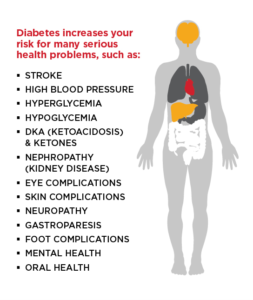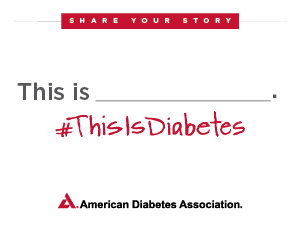Did you know that 1 in 11 Americans today has diabetes? Despite its prevalence, diabetes is an invisible disease. It affects men and women, people young and old, and people of all races, shapes and sizes. Often there are no outward signs from the 29 million Americans who fight this chronic illness every day. That’s why there is a critical need to foster awareness and education while breaking down stereotypes, myths and misunderstandings about this disease.
 For many, diabetes dictates how they organize their day, what they eat at every meal, how they choose to be physically active and how they spend their money. People with diabetes can have health care costs that are 2.3 times higher than someone without diabetes, as type 1 and type 2 require very specific forms of treatment.
For many, diabetes dictates how they organize their day, what they eat at every meal, how they choose to be physically active and how they spend their money. People with diabetes can have health care costs that are 2.3 times higher than someone without diabetes, as type 1 and type 2 require very specific forms of treatment.
Type 1 diabetes is an autoimmune disease usually diagnosed in children and young adults. Approximately 5 percent of people with diabetes have type 1, which means their body does not produce any insulin. Insulin is critical in order for the body to transport glucose (sugar) from the bloodstream into cells for energy. People with type 1 diabetes must take insulin every day to live.
Type 2 diabetes is the most common form of diabetes, accounting for 90 to 95 percent of cases in the United States, and is caused when the body does not produce or use insulin properly. Risk factors for developing type 2 diabetes include being overweight, having a family history of diabetes and having diabetes while pregnant (gestational diabetes). Some people with type 2 diabetes can control their blood glucose (sugar) by managing their diet and staying active. Others may require oral medications or insulin as the disease progresses. Type 2 diabetes is more common in African Americans, Latinos, Native Americans and Asian Americans/Pacific Islanders, as well as older adults.
Some women develop gestational diabetes, high blood glucose (sugar) levels during pregnancy, which requires treatment to protect the health of the mother and the baby. Gestational diabetes affects approximately 9.2 percent of pregnant women.
 Eating a healthy diet and exercising regularly are good for everyone. They become essential if you have been diagnosed with diabetes.
Eating a healthy diet and exercising regularly are good for everyone. They become essential if you have been diagnosed with diabetes.
Sticking to your diet and exercise plans can help you reduce the risk of complications from diabetes such as heart disease, high blood pressure, stroke, and certain types of cancer. Before you start on a new diet or exercise regimen, however, we strongly suggest that you talk to your doctor or dietitian.
The Benefits of Exercise
You do not have to go to a gym, buy lots of expensive equipment, or get involved in organized sports to reap the benefits of physical activity. Dancing, swimming, walking, bicycling, skating – even gardening and housecleaning all get your heart pumping. Just 30 minutes of physical activity a day can help lower your blood sugar, blood pressure, and cholesterol levels, all of which are important to watch if you have diabetes.
Another benefit of exercise is weight control. If your doctor advises you to lose weight as part of your diabetes treatment, exercise may help – but be sure to avoid eating more just because you’ve exercised. Weight loss also reduces insulin resistance, allowing your natural insulin to more effectively lower your blood glucose level. If you are at a healthy weight already, exercise provides many other benefits, including reducing your risk of heart disease and stroke. That is an important benefit when you consider that people with diabetes are about twice as likely to get cardiovascular disease.
Watch Your Diet
Your eating habits are vital when you have diabetes. That is, while you must control how much food you eat, when you eat and the kinds of foods you eat take on added significance. This is because your choice of food and the size of the portions affect your blood sugar level. Talk with your doctor or dietitian to learn what, when, and how much you should eat to keep your diabetes in check.
Your doctor may suggest that you alter your consumption of carbohydrates or time it to ensure that you avoid both glucose spikes and hypoglycemia (low blood sugar). Because high-carb foods such as bread, cereal, corn, crackers, fruit, milk, noodles, peas, rice, and tortillas can spike your insulin, they are likely to advise that you eat only a little at a time. Finally, the standard dietary advice to eat plenty of vegetables – three to five servings each day – is even more important for diabetics.
These changes might amount to a radical departure from your typical diet but do not fret: plenty of cookbooks and web sites, aimed at people with diabetes, contain recipes that are healthy and tasty. Check your local library or bookstore.
For more information on nutrition, exercise, and diabetes, consult these web sites:
- The Centers of Disease Control and Prevention keeps this web site with recipes and a meal planner guide for people with diabetes.
- Your Motivation Alliance food log lets you track your diet. You can use this to track – and control – how much simple carbohydrate you are consuming.
- The American Diabetes Association web site contains tips on making healthy food choices. They also provide the “My Food Advisor” site to help you with recipes and dietary advice.
Thank you to the American Diabetes Association for providing images and part of the content of this article!
Food Tips
The following food tips will help you stay on track to better health:
- Eat a variety of foods and watch your portion sizes.
- Choose foods high in vitamins, minerals, and fiber. This typically means eating fresh rather than processed foods.
- Cut down on sweets.
- When eating grains emphasize whole-grain varieties.
- Eat fish two to three times a week.
- Avoid foods and oils high in trans fats.
- Drink water and calorie-free drinks instead of regular soda and other sweetened drinks.
- Cut back on high-calorie snacks and desserts such as cookies, cakes, and ice cream.


This is very good information about diabetes. My son is over weight and I’m scared that he get juvenile diabetes. We are seen a dietician but it is very hard to change eating habits. We are trying to help him do more exercise as well.
Hi Isela! We’re sorry to hear your son is overweight. Exercise is a proven method to prevent diabetes. Find an activity that your son enjoys and get him moving whenever you can. Support him in his efforts to eat better and move more and things will turn around. It can be frustrating to establish healthy habits at first but stick with it. Together you can do it!
MY son had juvenile when he was in the 6th grade . When he got to the 7th grade. He started playing sports and working out and before I knew it Elijah had slimed down. He was longer in a husky. It was hard at first for him.
Avoid eating late at night, soft drinks, junk food. Load up on green vegetables. Walk every day
I have been eating a kale smoothie with banana, ginger, and OJ every morning. Works to control appetite and the kale helps lower the sugar
Good info about diabetes, it runs in my family on my dads side
Sorry to hear that. All the more reason to exercise, eat real food and keep away from excessive sugar. 🙂
finally got my sugar under control
Nuts and fruits seem to be holding me.
I have type one diabetes. I was diagnosis at the age of 12. I am happy to say that I have not had nay major complications. Many people look at me and say oh your are good cause you have an insulin pump and you don’t have to take shots everyday. but little do they know it still a struggle to manage my blood sugar everyday. I still have to check my blood sugar and watch what I eat and still count carbs. But I know that I have to take good care of myself because its not just about me anymore its about my family also. So I make sure I do what I need to do to keep me well so that my family can see me here for the long run. Diabetes is a manageable sickness you just have to make sure that you are managing IT.
Wow Tahirah, thanks for sharing your inspiring story. It sounds like you are doing a great job controlling your diabetes and keeping your priorities straight. Keep up the good work and thanks for being an example to us all!